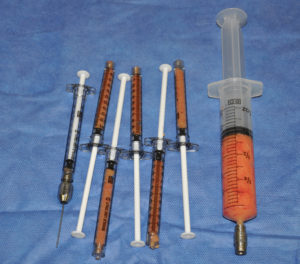
But no matter where it is placed, how do fat grafts survive? Just because it is widely used does not mean that its transplantation biology is well understood or always works well. What it does indicate is that fat grafting is highly safe and comes often with an aesthetic improvement from the liposuction harvest site. So even if the fat graft take is suboptimal, the harvest site achieves a liposuction type that is most evident in large volume fat grafting procedures.
The adipocyte cell survival theory is historic and dates back to the 1950s from a human study by Lyndon Peer. In reading his detailing of the history of composite fat grafting done extensively in the first half of the twentieth century and in his own human abdominal transplant study (which could never be replicated today), survival was based on acquiring a quick vascular reconnect. It was the rapid hookup of the recipient site vessels to those in the chunk of fat implanted that accounted for an average 50% survival of relatively small grafts. This percent survival number remains oft quoted today but that is inappropriate given most of today’s fat grafts are particulated by liposuction.
More recent experimental studies, however, do lend support that early vascular perfursion is important to the transplanted cells. Those cells furtherest away from contact with the recipient tissues undergo cell death while those closest to it largely survive. This has become known as differing zones of an injected fat graft and speaks to the fine layering or droplet approach to maximize host contact.
The host replacement theory, which is actually historic as well (read Peer’s original book chapter on fat grafting) has been ‘rediscovered’ by several well done experimental studies. It has been shown that many adipocytes after transplantation undergo degenerative changes and adaptive tissue remodeling. While some adipocytes will die, adipose-derived stem cells (this cell type was not recognized fifty years ago) survive, become activated and contribute to adipose tissue repair. Since fat is now known to be replete with stem cells, it has become assumed that this is a primary contributor to volume retention after particulated fat grafting. This has been experimentally demonstrated in the regenerative zone of fat grafts where fat cells die and stem cells survive to replace those fat cells lost.
Both the cell survival and host replacement process contribute to the dynamic remodeling of adipose tissue after fat grafting. The ratio of their contribution to the success of fat grafting is undoubtably influenced by many factors of which the individual patient, graft site and graft size are but just a few of them. Graft survival may be more dominant in some patients, while host replacement may be so in others.
The important roles of harvesting and processing fat, while undergoing a lot of investigations currently, has still not identified the exact factors that optimize adipocyte cell viability. The harvesting and processing issues are becoming more clear and they are much easier studied and controlled because they are done outside of the body. It is the injection technique that remains the most uncontrolled variable since it is manually done by the surgeon. The microdroplet or fine linear layering of the graft is well accepted because it increases host-graft contact for more rapid revascularization. But doing it manually makes it an imprecise part of the procedure and thus more difficult to study. This shall remain the ‘artistic’ part of the procedure for years to come.
One of the very useful side benefits of injectable fat grafting is the enhanced neovascularization it causes in the recipient site regardless of the fat volume that survives. This has great utility in the treatment of compromised tissues, particularly irradiated tissues. It is clear that there are many growth factors in fat which are not necessarily carried by stem cells. This has led to fat grafting being used more and more like a cell-directed therapy for regeneration rather than just a soft tissue filler. It can be expected to see this role for fat grafting increase in the future.
Dr. Barry Eppley
Indianapolis, Indiana


